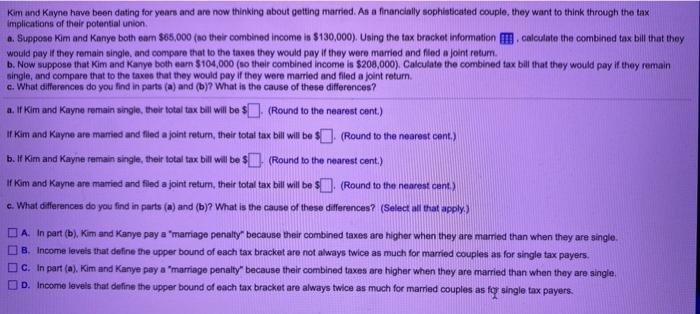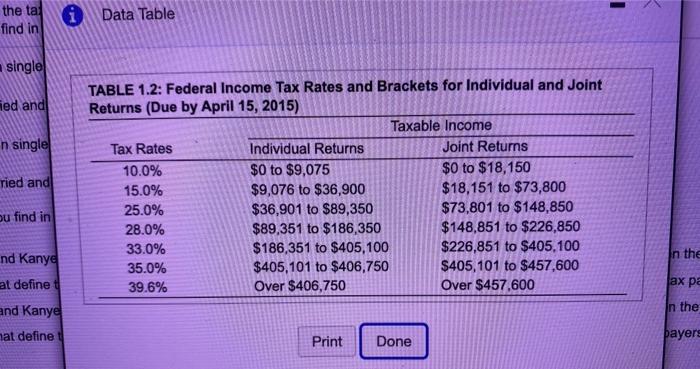Kim and Kayne have been dating for years and are now thinking about getting married. As a financially sophisticated couple, they want to think through the tax implications of their potential union a. Suppose Kim and Kanye both eam $65,000 (no their combined income is $130,000). Using the tax bracket information calculate the combined tax bill that they would pay if they remain single, and compare that to the taxes they would pay if they were married and find a joint ratum. b. Now suppose that Kim and Kanye both earn $104,000 (so their combined income is $208,000). Calculate the combined tax bill that they would pay if they remain single, and compare that to the taxes that they would pay if they were married and filed a joint return. c. What differences do you find in parts (a) and (b)? What is the cause of these differences? a. I Kim and Kayne remain single, their total tax bill will be $ . (Round to the nearest cont.) Kim and Kayne are married and filed a joint return, their total tax bill will be $ (Round to the nearest cont.) b. Kim and Kayne remain single, their total tax bill will be $ (Round to the nearest cont.) If Kim and Kayne are married and filed a joint retum, their total tax bill will be $(Round to the nearest cant) c. What differences do you find in parts (a) and (b)? What is the cause of these differences? (Select all that apply.) A. In part (b), Kim and Kanye pay a marriage penalty because their combined taxes are higher when they are married than when they are single B. Income levels that define the upper bound of each tax bracket are not always twice as much for married couples as for single tax payers. C. In part (a). Kim and Kanye pay a marriage penalty because their combined taxes are higher when they are married than when they are single D. Income levels that define the upper bound of each tax bracket are always twice as much for married couples as for single taxpayers. the ta find in Data Table single ied and n single ried and TABLE 1.2: Federal Income Tax Rates and Brackets for Individual and Joint Returns (Due by April 15, 2015) Taxable income Tax Rates Individual Returns Joint Returns 10.0% $0 to $9,075 $0 to $18,150 15.0% $9,076 to $36,900 $18,151 to $73,800 25.0% $36,901 to $89,350 $73,801 to $148,850 28.0% $89,351 to $186,350 $148,851 to $226,850 33.0% $186,351 to $405,100 $226,851 to $405,100 35.0% $405,101 to $406,750 $405,101 to $457,600 39.6% Over $406,750 Over $457,600 ou find in nd Kanye In the at define t ax pa and Kanye In the mat define Print Done payers








